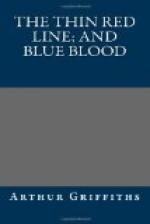McKay was marched out of the marquee, still under the escort of Cossacks. But outside he was presently handed over to a fresh party; they brought up a shaggy pony—it might have been the fellow of the one he had left behind the previous night—and curtly bade him mount. When, with hands still tied, he scrambled with difficulty into his saddle, they tied his legs together by a long rope under the pony’s belly, and, placing him in the centre of the escort, they started off at a jog-trot in the direction of the town.
CHAPTER III.
A PURVEYOR OF NEWS.
Mr. Hobson gave his address at Duke Street, St. James’s, a lodging-house frequented by gentlemen from the neighbouring clubs. But he was never there except asleep. There was nothing strange in this as none of the occupants of the house were much there, except at night-time—they lived at their clubs.
So, for all the landlady knew, did Mr. Hobson. But we know better. He had no club, and his daily absence from breakfast—simply a cup of coffee and a roll, which he took in the French fashion, early—till late at night was to be accounted for by his constant presence at his office or place of business, although it was both and neither. This was in a little street off Bloomsbury, the first floor over a newspaper shop.
Mr. Hobson passed here as an agent for a country paper. It was supposed to be his business to collect and transmit news to his principals at a large seaport town on the East Coast. These were days before the present development of newspaper enterprise, when leading provincial journals have their own London offices and a private wire. Mr. Hobson’s principles were very liberal according to the idea of that time; they seemed to grudge no expense with regard to the transmission of news.
Telegrams were costly things in those days, but Mr. Hobson sometimes sent off half-a-dozen in the course of a morning. He was served too, and exceedingly well, by special agents of his own, who came to him at all hours—in cabs driven recklessly, or on foot, in a stealthy, apologetic way, as though doubtful whether the news they brought would be acceptable.
The office upstairs bore out the notion of the news-agency. Its chief furniture consisted of two long, sloping tables, on which lay files of daily papers. There was one big book-case handy near the fireplace, and over the desk at which Mr. Hobson sat. On the shelves of this were ranged a couple of dozen volumes, each bearing a label on which were various letters and numerals.
On the desk itself were the usual writing appliances, a large pair of scissors, and a wide-mouthed bottle of gum.
Let us look in at Mr. Hobson on his first arrival at his office, soon after eight o’clock.
His first business was to ring his bell, which communicated with the shop below.
“My papers! It is past eight.”




